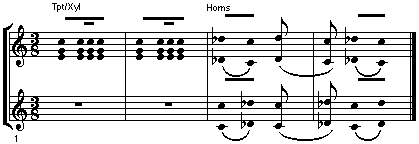







Harmonically, Herrmann uses dissonance to represent tension, suspense, or the irrational. Even the love theme lapses into dissonance when necessary. In "Conversation Piece," the porter's knock at the door prompts the music to end on an E flat augmented triad, and as "Duo" ends and we see Eve's disturbed look as she considers the note she has sent to Van Damm, the theme ends on a G flat triad with a diminished fifth. Some of the overture is extremely dissonant, as in the following example played contrapuntally by the woodwinds:

Ex. 11, Woodwind Dissonance in North by Northwest Overture by Bernard Herrmann.
The most dissonant section of the overture has the four horns alone playing in half steps against each other (measures three and four):

Ex. 12, Semitone Dissonance in North by Northwest Overture by Bernard Herrmann.
Unlike most Hollywood composers, Herrmann avoided using the "leitmotif" or theme. Instead, he generally used very short motifs or "cells" and often did not assign them to specific characters or ideas. It should be noted that the overture is completely non-melodic, with huge unsingable and dissonant melodic leaps (as well as modulations) and is entirely motivic. I have already mentioned the "journey" and "Van Damm" motifs, both of which are very short. The love theme is a full theme, but it is actually very simple and is founded on the remarkably basic two-note motif of a diatonic step downward, which is repeated to form the full melody. In one sense, this motion could be seen as coming from the opening timpani movement, which moves from B flat to A. Interestingly, the "Interlude" also ends with harmonic motion from B flat to A. At the same point, Herrmann slows the tempo down, preceding the stopping of the train.
Another short motif has been referred to by Royal S. Brown as the "Kidnap Motif," since he claims that it comes from two earlier Herrmann scores, both with kidnapping scenes, On Dangerous Ground (RKO, 1951, directed by Nicholas Ray) and The Man Who Knew Too Much (Universal, 1956).31 This four-note motif has many incarnations, all of which move downward. 32 Two early cues in the film use an abbreviated three-note inversion of the kidnap motif, the first being "The Door," when Roger is left alone in the library and discovers the door to be locked. This cue is interesting because in mood it is unlike anything else in the film. The melody is quite pastoral and warm, yet lonely, and is played in the flutes and violins. This is the first time in the film that Roger is alone. As Hitchcock has gone to great lengths to show us that the bustling city is his home environment, Herrmann has written a quiet, secluded piece to show his solitude. The second cue follows, "Cheers," when Roger is forced to drink bourbon. Although based on the same motif, it is put in the basses where it is much more threatening. Two cues use the trumpet/xylophone motif from the overture, (see Example 12, above) both of which are near the beginning of the film and feature Roger's mother. The first is "Two Dollars" ("Oh, Roger, pay the two dollars") and the second follows in "The Elevator," in which Roger and his mother are followed by two of Van Damm's (Townsend's) men into a crowded elevator. Hitchcock's recurring character of a domineering mother warrants her own motif in the film. Although she is only in these few scenes, her presence is suggested in every action scene that quotes the overture.
The examples listed above from North by Northwest illustrate how Bernard Herrmann can be considered one of Hollywood's great composers, even though he rejected the musical standards and traditions of the idiom at the time. In turn, he created his own original and distinctive sounds. His use of orchestration and harmony went far beyond many of his contemporaries as film composers and was founded more on the composers of the twentieth century. His adaptation of these ideas to film presented a new structure to film music, placing it only where he felt music was absolutely beneficial to the narrative, rather than in any emotional scene, and replacing the too noticeable melody with a simpler motivic idea. This singular sound was the perfect complement for the Hitchcock films, and in particular North by Northwest. As Herrmann himself has said, "Hitchcock only finishes a film sixty percent. I have to finish it for him."33 Herrmann's sound was an important and integral part of the Hitchcock films, and without the scores the films would certainly not have the same effect, nor would they be measured the same way as great works.




31
Brown, p. 40.
32
It is used not only in "The Phone Booth," and "The Question," but also in "Flight"
(when Eve runs away in the forest after Roger learns that she plans on leaving
with Van Damm), and in "The Balcony," "The Match Box," "The Message," and "The
TV," all of which are scenes of extreme tension.
33
Brown, p. 14.